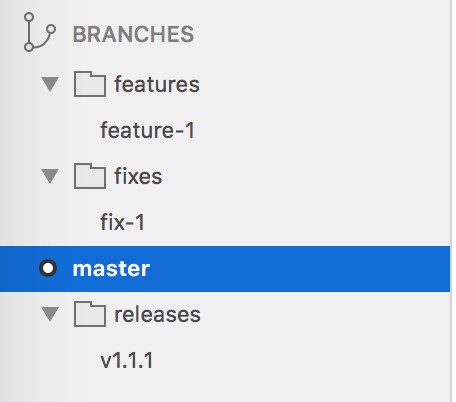Implementing Git in a team can feel like navigating a maze, especially when you’re also learning React. Many developers, including myself, initially turned to “Git Flow” as a guiding star, inspired by Vincent Driessen’s model. However, as projects evolve, and particularly when focusing on learning React, rigid structures might not always be the best fit. Over time, exposure to diverse workflows within the development community has shown me that the “best way” is often context-dependent.
Before we dive into specific branching styles ideal for React learning, it’s crucial to remember a fundamental aspect of Git: branch organization is logical, not physical. While Git clients often visualize branches in folders using slashes (“/”), Git itself doesn’t inherently recognize directories in branch names. This visual representation is a UI convention, not a Git specification.
Let’s explore several effective strategies for organizing your Git branches that can significantly enhance your React learning journey and keep your codebase organized as you grow.
Gitflow for React Learning: A Structured Start
Gitflow, with its feature, hotfix, and release branches, provides a robust framework, especially for larger projects. For React learning, adapting Gitflow means understanding its core folders:
feature/: Branches for developing new React components or features. For example,feature/user-authenticationorfeature/responsive-design.hotfix/: Branches to quickly fix bugs in your React application.hotfix/login-errororhotfix/typo-in-form.release/: Branches to prepare for a version release of your React project.release/v1.0.0.
While Gitflow doesn’t strictly enforce folder structures, using these prefixes helps categorize branches logically.
Enhanced Gitflow for React Projects: Adding Context
As your React learning projects become more complex, extending Gitflow can be beneficial. Consider adding these folders:
docs/: For branches focused on documentation updates, important when learning and documenting React components or project setup.docs/component-apiordocs/project-setup.task/: For branches handling refactoring, cleanup, or configuration changes, common tasks when improving React code.task/refactor-form-validationortask/update-webpack-config.
These additions offer more granular organization, particularly useful for solo learners or small teams working on React applications.
BPMP (Branch-Push-Merge-Prune) for Rapid React Learning
The Branch-Push-Merge-Prune (BPMP) method is the minimalist approach. It’s excellent for keeping your working copy clean and focused, especially when you’re rapidly experimenting and learning React concepts.
With BPMP, you create a branch for each learning task or experiment, push it to remote, create a pull request, and delete the branch after merging. This method avoids branch clutter and is ideal for smaller, learning-focused React projects.
Module-Based Branching for Component-Driven React
For larger React applications or when learning modular React architecture, module-based branching can be highly effective. Organize branches by React modules or components:
components/: For branches dedicated to specific React components.components/user-profileorcomponents/shopping-cart.features/: Organize by feature areas of your React app.features/authenticationorfeatures/product-catalog.
This approach aligns well with React’s component-based nature, making it easier to manage changes within specific parts of your application.
Version-Based Branching for Tracking React Learning Stages
Version-based branching is excellent for projects with clear milestones or learning stages, such as tracking progress through different React versions or tutorial series.
v1.0/: Branches for features or fixes related to the first version or stage of learning.v1.0/add-basic-routingorv1.0/fix-component-styling.v2.0/: Branches for the next learning phase.v2.0/implement-reduxorv2.0/optimize-performance.
This time-oriented approach helps in managing learning progression and easily archiving older stages with simple Git commands.
Ticket-Based Branching for Task-Driven React Learning
If you’re using task management systems or issue trackers in your React learning, ticket-based branching is a natural fit. Branches are named or organized based on ticket or issue numbers:
tickets/123/: For branches related to a specific learning task or bug fix tracked as ticket #123.tickets/123/implement-form-validation.issues/456/: For branches addressing issue #456, likeissues/456/resolve-dependency-conflict.242/: Simply using the ticket number as the branch name can also be effective.242/add-unit-tests.
This method directly links your Git branches to your learning tasks, streamlining workflow and tracking progress.
Emoji-Based Branching: For Visual Learners (and Fun!)
For a more visually distinct and perhaps fun approach, consider emoji-based branching. While less conventional, emojis can quickly categorize branch types:
✨feature/: Using a sparkle emoji for new features.🐛fix/: Bug emoji for fixes.📚docs/: Books emoji for documentation.
This playful method can make branch identification quicker at a glance, especially in personal learning projects.
Choosing the Best Branching Strategy for Your React Learning
The “best way” to organize Git for React learning isn’t one-size-fits-all. For beginners, starting with a simplified Gitflow or BPMP approach is often recommended due to its clear structure and ease of use. As your React projects grow in complexity, module-based or version-based branching might offer better organization.
Key Takeaways for React Learners:
- Start Simple: Begin with a branching strategy that is easy to understand and implement.
- Consistency is Key: Choose a style and stick with it to maintain clarity.
- Team Agreement (if applicable): If learning in a team, agree on a branching style together.
- Regular Cleanup: Frequently prune merged branches to keep your repository tidy and efficient.
Ultimately, the goal is to choose a system that supports your learning process, keeps your work organized, and allows you to effectively manage your React projects. Experiment, adapt, and find what works best for you.
Happy coding in React!
Originally inspired by practices discussed at harkoded.com.

